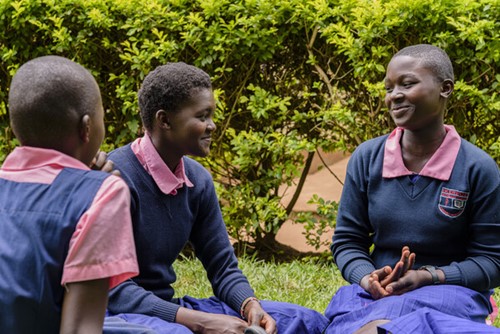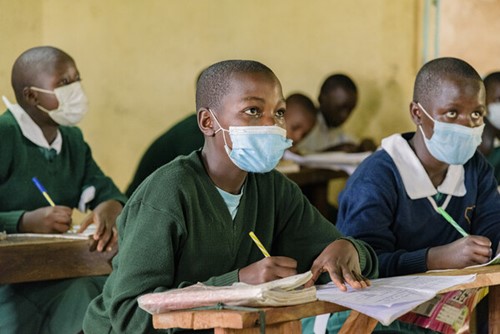Blog
Final reflections on the Leonard Cheshire project in Kenya
Context
Children with disabilities face a range of barriers to accessing and remaining in education, and actively participating and learning. These barriers include discriminatory attitudes and behaviours related to social norms, lack of trained teachers in inclusive education, inappropriate infrastructure and policies, and limited resources. Therefore, girls with disabilities are less likely to enrol in education and those who do go to school tend to have lower attendance rates. So that means they’re less likely to complete their education.
Through our Girls’ Education Challenge (GEC) project, Leonard Cheshire has been working in Kenya to address these barriers for children with disabilities and ensure a smooth transition for children from primary to secondary education and/or vocational training thus preventing children from dropping out and improving their life chances in the future. We have taken a systems approach, working to create accessible, inclusive, and sustainable change at an individual, community, school and policy level, both locally in the Lake Region of Kenya and nationally.
At the outset of the project, our aim was to significantly change the attitudes of the community towards disability inclusion. In school, we wanted to support girls with disabilities to be better included, to participate in learning, to be able to transition smoothly through education levels and to enjoy their school experience; with our model to be adopted in the country at scale. We also aimed to get endorsement of our inclusive education model from the government, including a commitment to roll it out across the country and build on the teacher training element.

Progress
Since 2017, our project has supported 2,100 girls with disabilities and 678 boys with disabilities. We have worked in 83 educational institutions including 50 primary schools, 25 secondary schools and eight vocational institutions across five sub-counties of the lake region: Kisumu East, Siaya, Homabay, Migori and Kuria East.
We have supported girls with disabilities to progress within mainstream primary schools and successfully transition to secondary education and vocational institutes. And we’ve helped improve learning outcomes in literacy and numeracy for the children we’ve worked with. We also worked with the Kenyan government and local authorities to take forward inclusive education practices to ensure the sustainability of our work.
The success of our programme has been anchored in supporting the attendance levels of girls with disabilities, promoting the adoption of inclusive education practices by teachers, raising girls’ self-esteem, supporting changes to the inclusive education policy environment, and promoting improved attitudes and practices at the community level.
Responding to COVID-19
The unexpected closure of schools significantly interrupted the learning outcomes for all learners. Unfortunately, many girls were unable to access remote learning and dropped out of education entirely. So, our project had to make some very rapid adaptations to continue to support the girls and their families while at home. We conducted telephone surveys to understand the needs of the girls and their families. And worked to provide the relevant response to ensure we could reach as many of the girls as possible. Despite the restrictions, we had positive outcomes, especially on social inclusion, teacher confidence and even learning outcomes.

Achievements
Overall, the project has had a significant impact on reducing the barriers to education for girls with disabilities.
Perhaps one of the most significant impacts of the project has been the work we carried out to change community attitudes towards disability. Through aspects like the male mentorship programme and the Parent Support Groups (PSGs), parents have been encouraged and supported to send their girls with disabilities to school, when previously stigma around disability meant they may have been more likely to keep them at home The mentorship programme and PSGs taught fathers and community members about the importance of inclusion, especially for the girl child breaking down misconceptions and other barriers around disability. They really helped the community to become much more inclusive of children with disabilities in community activities and especially education.
Within schools, other elements like Child-to-Child Clubs and peer mentorship have been instrumental in supporting girls with disabilities to develop social skills and improve their self-esteem. As well as motivating them to attend and participate in school. The project also worked closely with teachers and the Education Assessment and Resource Centres (EARC’s) providing in-service training on screening and identification of children with disabilities using the Washington Group of Questions, inclusive education pedagogy, practical skills and individual education plans. By the end of the project, the teachers and EARCS were collaborating very well, providing education support for children with disabilities in mainstream schools.
Schools were also supported to establish school-based inclusion teams (SBITs) to help foster more inclusive learning environments. The SBIT has been found to be an effective mechanism for promoting a whole-schools approach to inclusive education, infusing an ethos of teamwork and participation, providing local solutions for ensuring that schools and the communities within which they are located to respond positively to diversity. School environments have become increasingly accessible and teaching methods more relevant and appropriate for children with disabilities.
This social inclusion, along with the capacity building and interaction of the Child-to-Child Clubs positively impacts on the girls’ feelings self-esteem and confidence, which results in an increased likelihood that they will attend and perform well in school.
By the end of our project, girls with disabilities were equally as likely to attend school as girls without disabilities – a great result. Girls with and without disabilities were equally likely to successfully transition through school pathways. The project also intentionally promoted vocational training as an alternative pathway for girls with disabilities - and especially girls with intellectual disabilities - with outstanding results.
Legacy
Looking to the future, we expect that the SBITs will continue to promote a whole-schools approach to inclusive education. We have created lasting accessible learning environments, providing ramps and handrails, bigger windows and translucent sheets at many of the schools to allow more light in classrooms, assistive devices, and accessible teaching and learning materials.
The knowledge and skills the teachers have received through their training will remain with them for as long as they practice, creating more inclusive learning environments and transforming the lives of more children with disabilities in the future. The identification and assessment of children with disabilities and their needs has helped teachers become better acquainted with the needs of children with disabilities. This helps them plan and deliver different techniques for ensuring inclusive education. This also built the capacity of schools to provide school-based support rather than refer learners elsewhere for the support that the need in their education.
Importantly, the self-confidence of the children with disabilities and the increased awareness of their non-disabled peers will have transformed the way they think and act in the years to come.
Lessons learned
Through our GEC project, we have learned that building programmes within existing government structures and policy guidelines and working with national government is essential, and that real systemic change can only happen at national level.
We observed that working in disability inclusive development does have additional costs such as assistive devices and assistive technology, infrastructural adaptations, teacher training at scale and transport – but this investment is fundamental to success.
We also gained insights that although our project contributed to improving teacher’s capacity to implement inclusive practices, these can only be fully realised within a broader enabling environment, within which structural barriers are addressed. These include a reduced pupil to teacher ratios, and performance reviews that are responsive to differentiated teaching and assessments.
*The use of art to collect stories of change and impact has been very successful and is a very powerful advocacy tool.
++++++++++++++++++++++++++++++++++++++++++++++++++
Further resources from the project
Final reflections: Achievements and lessons learned
Case studies: Stories of change
Case study: Gathering insight through art
Case study: How Boke is focusing on her future
Case study: How male mentoring is changing girls' education
Case study: Using technology to create positive learning environments
Case study: Vanessa's journey to education
Case study: Sophie Morgan's inclusive journey to Kenya